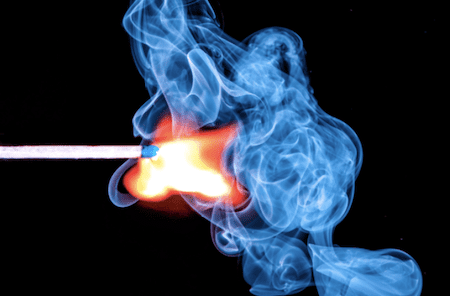Catching your tent on fire is one of the most terrible mishaps you could encounter on your camping trip. To be on the safe side, it’s always best to get your tent fireproofed before embarking on your camping journey.
Although the task of making your tent fire retardant might seem daunting, it’s not as tricky as you might think.
There are plenty of ways to make your tent fire retardant. From buying a fire retardant tent to using various substances, just pick the one that suits you well.
To help you throughout the entire process, we have compiled an easy-to-navigate and straightforward guide on how to make a tent fire retardant.
Here is everything you need to know to make your tent fireproof!
How To Make A Tent Fire Retardant
Making a tent fire retardant is not that hard of a task. You need the right tools, proper measurements, and the correct procedure.
Here are three ways you can make your tent fire retardant, all described in detail so that you don’t have to worry about catching your tent on fire.
#1. Using A Fire Retardant Spray
The easiest way to make your tent fire retardant is by using a fire retardant spray. There are multiple fire retardant sprays available on the market.
Before buying a suitable one for your tent, you need to do some research and follow some simple steps to make your tent fire retardant.
First, you need to buy a fire-retardant spray from a renowned reliable source like Natfire.
Check that the spray meets with fire safety rules set out by the American Society for Testing and Materials, the National Fire Protection Association, or Underwriters Laboratories before purchasing.
These organizations ensure that the product complies with all safety regulations. Make sure the product is acceptable for a canvas tent by reviewing the material on the bottle.
If you’re not sure, check the retailer’s website, contact a salesperson in the shop for advice, or ask the manufacturer.
How To Use A Fire Retardant Spray
- To apply the spray correctly to your tent, first wash it with lukewarm, soapy water.
- Remove any remaining debris to make the area clean. The performance of the fire-retardant spray will be reduced if the tent is fireproofed while crusted with mud or cobwebs. The tent should then be let dry.
- In an open area, lay the tent down on the ground. As a safety precaution, keep young children and pets away from the spray to avoid getting in touch with it or breathing the fumes.
- Then, following the manufacturer’s instructions, apply the fire retardant spray on the tent. It might vary somewhat from product to product, so always read the instructions before using your spray.
- Allow the spray to soak into the fabric for the period specified. It depends on the product as well. The tent must be left for 24 hours while the substance cures.
#2. Making Your In-House Solution
If you forgot to bring a fire retardant spray or want to make your solution at home, we have just the recipe for you.
To make a fire retardant spray yourself, you will need a few simple materials and the correct measurements to get it right.
How To Make In-House Fire Retardant Solution
- Buy a package of borax first. For this project, avoid buying any detergent that contains borax.
- Take a container, and fill it halfway with borax.
- In a mixing basin, combine 3 oz. boric acid and 2 qt. boiling water.
- After that, using a wooden spoon, thoroughly stir the mixture till the borax and boric acid blend.
- Lastly, using a funnel, transfer the solution into a spray bottle.
Remember to shake the mixture in the spray bottle before spraying it on the canvas of your tent. And after washing the fabric, reapply the solution since borax and boric acid are washed away.
This way, you can make and store your fire retardant spray at your home.
#3. Buying A Fire Retardant Tent
If you do not want to go through the hassle of learning how to make a tent fire retardant, you can always opt for buying a tent that is already fire retardant.
Most of the tents in the market already come with this feature, so you should not have any trouble finding a suitable tent in this case.
There is nothing remarkable about the tent fabric in fire retardant tents. This is about synthetic and canvas materials.
Synthetic materials include polyester, nylon, and polyethylene. On the other hand, canvas materials are cotton or polycotton.
There are some things you should remember before buying a fire-retardant tent. Whether or not a tent is coated with a fire retardant, it will burn if exposed to direct heat.
This is why it is advised not to use an open flame inside a tent and position your tent at an adequate range far from an open fire. If you have a plan to heat the tent with a candle, make sure to take safety precautions.
Safety Concerns That You Shouldn’t Ignore
Although flame retardants can be beneficial when used in tents, a growing body of research suggests that many of these compounds are linked to negative health impacts in animals and humans. Endocrine and thyroid disturbances are two examples.
The immunological, reproductive, and neurological systems can all be affected. Protracted contact with flame retardants has also been linked to cancer in several animal studies.
Polybrominated diphenyl ethers, or PBDEs, are fire retardant chemicals that retain and persist in the environment, have been discovered to be harmful to people, and have been linked to neuro-developmental difficulties in children and thyroid dysfunction in pregnant women.
These gases produce significant irritation, including painful breathing and airway edema. They can also produce incapacitation when exposed to high doses.
Human interaction with the tent fabric and materials causes the flame retardant to be transferred to the skin surface, resulting in human exposure.
Although some of these substances have a low dermal absorption rate, accidentally ingestion of these chemicals by hand-to-mouth transfer activities is possible. They may transfer to the hands and be absorbed by the skin.
You can even breathe them directly through the airborne dust. It’s especially true if you’re camping with children. If you’re using a flame-resistant tent, avoid making direct contact with the canvas as much as possible.
Inhalation of large quantities of organophosphates, such as TDCPP, which are harmful compounds used in fire retardants, occurs during tent pitching, use, and dismantling.
TDCPP is included on the Proposition 65 list of carcinogenic and reproductive substances since it is deemed a possible human carcinogen.
It interferes with immunological function and thyroid hormone signaling. Organophosphates pose substantial health concerns, ranging from migraines, dizziness, and nausea to seizures, sluggish pulse, breathing difficulties, and sometimes even coma.
Safety Measures That You Must Take
Suppose your tent has a chemical fire retardant. In that case, you should limit the health concerns by washing your hands after set-up and take-down.
Leave vents open to allow free-flowing airflow, and the flysheet off to enhance ventilation when possible. Avoid using open fires within the tent.
Although fireproofing a tent is a necessary measure, it can cause many health issues if you aren’t careful with the chemicals.
So, be sure to take care of your health while handling such toxic chemicals. It’s always best to be cautious for you and your loved one’s safety.
Tent Fire Retardant FAQs
What Is The Duration Of A fire Retardant Spray?
Unopened fire retardant canisters can last up to ten years. However, smaller ones bottled up at home or bought from retailers will last for a shorter period.
What Is The Best Way To Get Flame Retardant Out Of Clothes?
To get the fire retardant chemicals out of your clothes, rinse them separately in a Regular or Cotton cycle at any surface temperature up to 140 degrees Fahrenheit (60 degrees Celsius).
Use any ordinary household washing detergent, but avoid using animal fats soap. To avoid abrasion streaks, turn clothing inside out before washing.
What Are Fire-Resistant Materials?
The majority of the best alternatives for fire-resistant textiles are synthetic fibers. Although most natural fibers are combustible, heat causes plastic-based fibers to melt rather than ignite.
Is A Fire Retardant Washable?
A fire retardant is supposed to wash away in light to moderate rain. If any residue remains, it may be washed away at any time with running water.
Is Fire Retardant Harmful?
Fire retardants are typically regarded as non-toxic, although even less-toxic substances represent a risk to organisms when exposed in high quantities.
These compounds are used as flame retardants, although they are known to be environmentally hazardous.
What Are The Contents Of A Fire Retardant?
Long-term fire retardants are made up of roughly 85% water, 10% fertilizer, and 5% minor substances such as colorant, such as iron oxide, rust, or fugitive color that fades with sunshine, thickeners, natural gum and clay, corrosion inhibitors, stabilizers, and bactericides.
Conclusion
No matter how cautious you are, there is always a chance of some mishap catching you off guard on your camping adventure.
But make sure that the mishap is not your tent set on fire. To help with that, we hope this article helped you figure out how to make a tent fire retardant.
So, now you have one less thing to worry about on your next camping trip. Time to pack your bags and enjoy the great outdoors!


